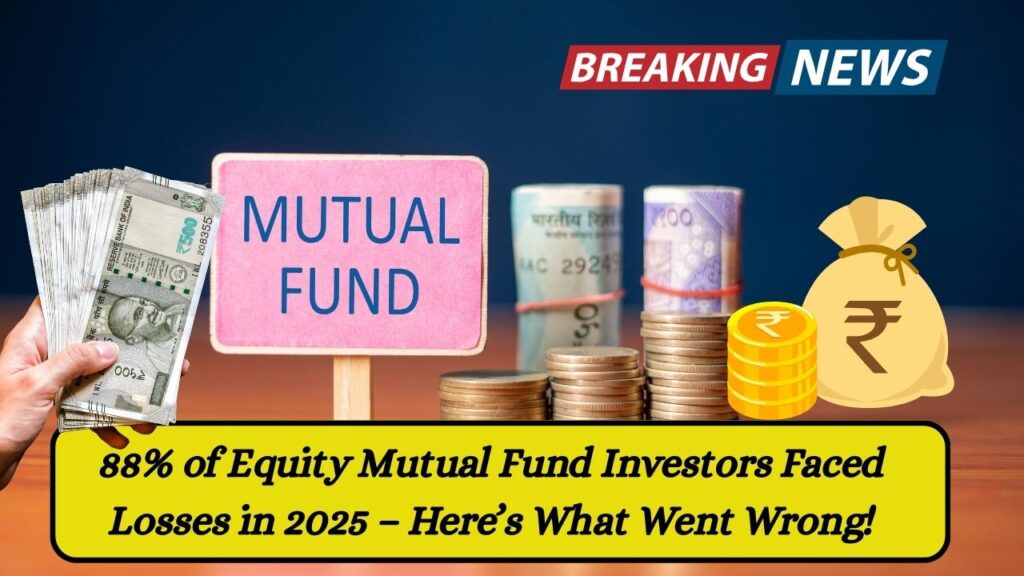88% of Equity Mutual Fund Investors Faced Losses in 2025 – In 2025, an alarming 88% of equity mutual fund investors in India reported negative returns, shaking the confidence of millions who had trusted these funds for wealth creation. From small-cap schemes to tax-saving ELSS options, the red ink was spread across the board. But what led to this widespread underperformance—and more importantly, how should investors respond?

This detailed guide breaks down the key reasons behind the losses, explains what steps investors can take now, and helps you understand the road ahead.
88% of Equity Mutual Fund Investors Faced Losses in 2025
| Particulars | Details |
|---|---|
| Loss Reporting | 88% of equity mutual fund schemes gave negative returns in 2025 |
| Worst-hit Schemes | Samco Flexi Cap Fund: -20.66%, LIC MF Small Cap Fund: -18.97% |
| Major Triggers | Global trade war, stock market crash, FPI outflows, rising inflation |
| Investor Impact | Most retail investors, especially SIP participants, saw capital erosion |
| Source & Data | Economic Times |
| Official Website for Mutual Fund Data | AMFI India |
2025 has been a rough ride for equity mutual fund investors. With 88% of schemes in the red, it’s understandable why many feel shaken. But market corrections are not new—and not permanent.
Instead of reacting emotionally, this is a time to review, realign, and reinvest smartly. Investors who stay disciplined during downturns often emerge stronger in the long run.
Understanding What Went Wrong in 2025
1. Global Trade Tensions: The Domino Effect
One of the biggest triggers was renewed global trade tensions. In early 2025, the United States reintroduced a slew of aggressive tariffs, particularly targeting imports from China and the EU. The Dow Jones Industrial Average plunged over 1,300 points in a single day, while the S&P 500 fell nearly 177 points, sparking panic worldwide.
India, being part of the global supply chain, was not immune. With reduced investor confidence and shrinking global demand, Foreign Portfolio Investors (FPIs) pulled out over ₹61,000 crore from Indian equity markets in Q1 2025 alone.
2. Stock Market Crash in India
The Sensex and Nifty saw significant declines throughout Q1 and Q2 of 2025. On February 28, Sensex plummeted by over 1,000 points, and Nifty breached critical support levels. The decline was not isolated to one sector—IT, finance, small-cap, and mid-cap segments all witnessed declines.
This crash trickled into mutual fund returns, with equity-heavy schemes—especially mid-cap and small-cap funds—taking the brunt.
3. Performance of Popular Funds: A Deep Red
Let’s look at some of the worst-performing funds:
- Samco Flexi Cap Fund: -20.66%
- LIC MF Small Cap Fund: -18.97%
- HSBC Small Cap Fund: -17.33%
- Samco ELSS Tax Saver Fund: -16.61%
- Motilal Oswal ELSS Tax Saver Fund: -15.79%
Out of the 336 actively managed equity schemes, 295 gave negative returns—a staggering 88%. Only a handful of index funds or sector-specific themes like pharma or FMCG managed to survive with modest returns.
4. Poor SIP Returns Despite Long-Term Investment
Many retail investors who had been consistently investing via SIPs (Systematic Investment Plans) also suffered.
Despite having a long-term investment horizon, many saw capital erosion, especially in mid-cap and thematic funds. Investors who started SIPs in early 2023 are now seeing 2-year IRR (Internal Rate of Return) drop below 1%, with some even facing negative returns.
5. Inflation and Rising Interest Rates
India’s inflation rate crossed 6.2% in mid-2025, well above the RBI’s comfort zone. The central bank responded with rate hikes, making fixed income instruments more attractive.
As a result:
- Investors began redeeming equity fund units to park funds in safer avenues like FDs and government bonds
- Equity funds saw a liquidity crunch, further intensifying the downfall
6. Increased Volatility and Lower Earnings Guidance
A wave of downgraded earnings expectations for major Indian firms worsened investor sentiment. IT and financial companies reported slower growth due to lower global demand and weak domestic consumption.
- Many large-cap companies missed earnings estimates in Q1 2025
- Small-cap firms faced margin pressures due to rising input costs
- Global economic uncertainty led to frequent market swings, discouraging fresh investments
7. Behavioural Mistakes by Investors
Many investors tried to time the market and shifted between funds or exited in fear. This behavior often leads to:
- Buying high and selling low
- Missing out on future rallies
- Increased tax liability due to short-term exits
Educating investors on emotional discipline and goal-based investing is essential.
How Can Investors Respond Now?
1. Don’t Panic Sell
It’s tempting to exit after a market crash. But locking in losses is the worst mistake.
- Stay calm
- Avoid knee-jerk withdrawals
- Assess whether your fund is underperforming the category or market
2. Evaluate Fund Categories
Funds behave differently in volatile markets:
- Flexi-cap funds offer better risk distribution
- Index funds may offer lower returns but also lower volatility
- Thematic or sectoral funds are risky and may not suit all investors
Rebalancing across debt, gold, and equity is recommended.
3. SIP Investors – Stay the Course
If you’re a SIP investor:
- Think long-term (5–10 years)
- Use this correction as an opportunity to accumulate more units
- Remember: SIPs work best in volatile markets due to rupee-cost averaging
4. Explore Balanced Advantage and Asset Allocation Funds
Balanced Advantage Funds (BAFs) and Multi-Asset Funds automatically shift allocations based on market conditions.
- Reduce downside risk
- Provide moderate growth
- Suit conservative investors
These are worth exploring in uncertain times.
What Should You Watch for in the Second Half of 2025?
1. US Elections and Global Policy Moves
The return of Donald Trump’s protectionist policies has already shaken the world markets. Any escalation in trade wars will hurt FII sentiment.
Stay updated on:
- US tariff changes
- China’s countermeasures
- Fed rate policies
2. Domestic Earnings and Reforms
Look for:
- Indian companies’ Q2 and Q3 earnings
- Possible GST or tax reforms in the Union Budget
- RBI’s interest rate stance in the next MPC meet
3. Sectoral Rotation and Emerging Themes
As the market recovers, some sectors will rebound faster than others.
- Pharma, consumption, utilities could outperform
- Avoid overexposure to volatile themes
- Keep an eye on government spending in infra and energy
ITR Filing 2025: What’s the Deadline and How to Avoid Late Fees
FAQs about 88% of Equity Mutual Fund Investors Faced Losses in 2025
Q1. Why did most mutual funds lose money in 2025?
Primarily due to a combination of global trade tensions, a domestic market crash, FPI outflows, rising inflation, and earnings downgrades that created negative sentiment in equity markets.
Q2. Is this a good time to stop my SIP?
No. SIPs are designed to ride out volatility. Stopping now may prevent you from gaining when markets recover. Continue unless your financial goals have changed.
Q3. Should I switch from equity to debt funds now?
Not necessarily. Review your asset allocation and only rebalance if you’re overexposed. Long-term investors should maintain some equity exposure for growth.
Q4. Are ELSS funds still good for tax saving?
Yes, but focus on funds with consistent long-term performance. Don’t choose just for 80C benefits; assess risk and return suitability.
Q5. Which mutual fund categories are safer during such downturns?
- Large-cap index funds
- Dynamic asset allocation (balanced advantage) funds
- Conservative hybrid funds
These typically offer better downside protection.
Q6. Can new investors start SIPs in 2025?
Yes. Volatility can work in your favor via rupee-cost averaging. Start with index funds or BAFs to ease into market cycles.









